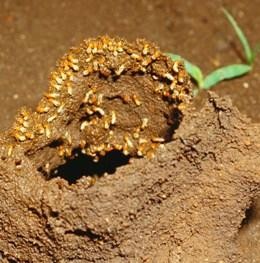The popular image of termites as major agricultural pests and destroyer of buildings may have to change.

Termites, nature's metallurgical engineers. Credit: Dinodia Photos/Alamy
Some 1,500 years ago Varaha Mihira an Indian astronomer, mathematician, and astrologer, in his treatise "Brihat Samhita" refers to termite mounds as indicators of underground water. Now researchers report1 that termites are also nature's metallurgical engineers. They have found that the hills which they build are an excellent source of quartz (SiO2) — a raw material for the semiconductor industry.
Through their routine activities, termites infuse substantial modifications to the soil on which the hill is built. The mounds are generally made up of sand grains and fine cellulose materials, which are coated with some sticky but readily hardening materials secreted by termites through their mouth or rectum.
The sculptured mounds shaped like mushroom, pyramid or cone created by these insects can be as big as five meters tall and eight meters in diameter. Termite hill soils become as hard as rocks on drying and their strength grows with time. They are well known for their high refractory properties since ancient times and find applications in brick making and house building.
"These interesting features of termite hill soils motivated us to study their physical and chemical properties using various analytical techniques," the researchers said. Although there are many reports about the beneficial qualities of termite hills, according to the scientists, "only a few mention or discuss the elemental composition and microstructures of the termite hills."
For their work, they collected termite mound soil samples from two different places: from a village near Dehradun in Uttarakhand and from a forest in Hauz Khas close to the Indian Institute of Technology (IIT), Delhi. They characterized the samples using powder X-ray diffraction, transmission electron microscope and field emission scanning electron microscopy. Quartz was found in both the samples. The Delhi sample also contained the rare 'cristobalite' phase of SiO2 .
Quartz which is a source for silicones, silicon and many other compounds of commercial importance, is crucial for a variety of applications in the semiconductor and software industry. Because of its outstanding thermal and chemical stability, quartz is widely used in many large-scale applications concerned with abrasives, ceramics and cement industry.
In nature quartz is found in igneous rocks like granite, sedimentary rocks like sandstone and shale. It is also present in sand and carbonate rocks. However, according to the report, natural quartz crystals contain too many chemical impurities and physical flaws and so are unsuitable for direct applications in industry. "The process of separation and extraction of quartz from sand and rocks is a multi-step process which includes physical and chemical methods of purification." Furthermore, the commercial processes of manufacturing pure, flawless, electronics-grade quartz called "cultured quartz" used in industry, involves highly controlled laboratory conditions.
According to the researchers, the termite mounds are source of quartz, available as SiO2 and also as the less common 'cristobalite' form of silica depending on their location. They found that apart from silica (as the major constituent), the termite hill soils also contain oxides of iron, magnesium and aluminium in considerable amounts. It has been earlier reported by other groups that termite hill soil contains as much as 20% of the total nitrogen as inorganic nitrogen, an average organic carbon content of 9.3% and 2.25 times more phosphorus than normal soil besides essential plant nutrients like potassium and calcium. The researchers said that all this suggests that "termite hill soils can be used over agricultural lands deficient in these elements."
While the studies highlight the possibility of producing quartz from all termite hills, "the soils need to be analysed before being used for any specific application, as composition and morphology may vary from location to location."
The authors of this work are from: the Institute of Nano Science and Technology, Mohali; Indian Institute of Technology, New Delhi and Hindu College, University of Delhi, India.
